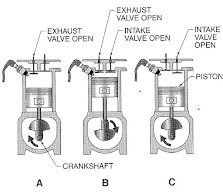Valve overlap is the period during engine operation when both intake and exhaust valves are open at the same time.
Valve overlap occurs when the piston nears TDC between the exhaust event and the intake event. The duration of valve overlap is between 10°-20° of crankshaft rotation, depending on the engine design. The intake valve is opened during the exhaust event just before TDC, initiating the flow of a new charge into the combustion chamber.
 |
| Valve Overlap |
 |
| Valve Overlap Period |
Valve overlap is designed into the engine and is most useful at higher speeds. At higher speeds, the head start in filling the combustion chamber provides a substantial increase in available power. The amount of time that both valves are open is directly related to engine rpm. The higher the engine rpm, the shorter the amount of time that both valves are open. The degrees of crankshaft rotation when both valves are open do not change. Only the amount of time both valves are open varies with the engine rpm. For example, at idle, the amount of time both valves are open is relatively long compared to top no-load speed.
No comments:
Post a Comment